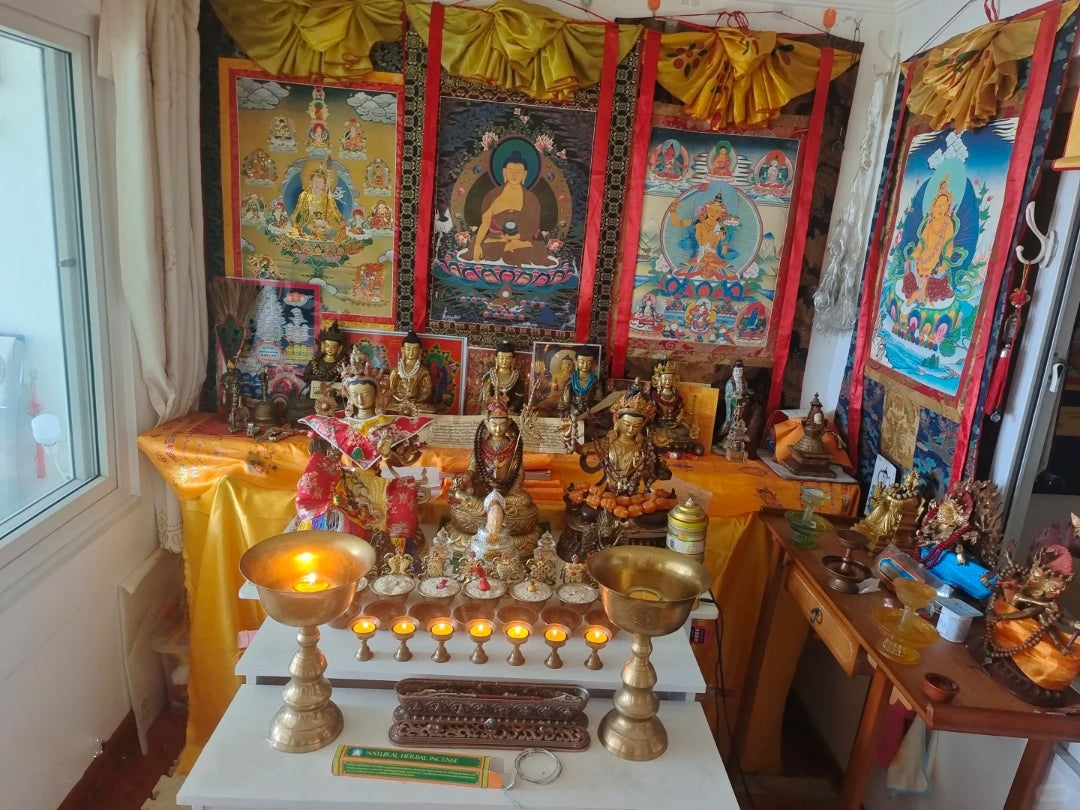Tibetan astrology is a living tradition that blends observation of the heavens with Buddhist ritual, folk beliefs, and practical life guidance. Unlike a simple “what’s my sign” system, it weaves together elemental cycles, animal years, and spiritual correspondences — often pointing people to a guardian deity or protective practice that suits their temperament and life situation. Below is a clear, practical introduction to the basics and how astrology historically guided the selection of guardian images and Buddhas.

The basics: elements and animal signs
Two interlocking systems form the backbone of Tibetan horoscope thinking:
1. The Five Elements.
Tibetan astrology uses five primary elements — Wood, Fire, Earth, Iron (Metal), and Water — which cycle through time and color the energy of years, months, and people. Each element carries qualities: Wood (growth, flexibility), Fire (activity, transformation), Earth (stability), Metal/Iron (clarity, structure), Water (adaptability, flow).
2. The Twelve Animal Signs.
Like other East Asian systems, Tibet recognizes a 12-year animal cycle (Rat, Ox, Tiger, Rabbit, Dragon, Snake, Horse, Goat/Sheep, Monkey, Rooster, Dog, Pig). Each animal expresses particular tendencies — social style, strengths, and recurring life themes.
Together, element + animal create a 60-year cycle (for example: Wood-Rat, Fire-Ox, Earth-Tiger, and so on). In practice, Tibetan astrology examines the interactions between these cycles to produce nuanced life charts.
What a Tibetan life chart looks at
A full Tibetan horoscope can be complex, but here are the common focal points:
-
Year, month, day, and hour of birth (each carries an animal/element signature).
-
Elemental balance: whether a person’s chart is heavy in one element (too much Fire, not enough Water) and what that suggests about temperament and health.
-
Astrological influences: favorable and challenging periods, often used to plan major events.
-
Deity correspondences: which protective deities, mantras, or ritual practices harmonize with the chart.
Practitioners traditionally consult a trained Tibetan astrologer (or lama with astrological training) to interpret a chart and recommend remedies or protectors.
Deities associated with horoscope needs
Over centuries, Tibetans developed associations between certain deities and life needs or animal signs. These correspondences guided devotional practice, ritual, and the choice of protective images. Below are commonly suggested guardians by sign (a helpful starting point, not an absolute rule):
-
Rat: Thousand-Armed Avalokiteśvara (great compassion and aid in crises)
-
Ox / Tiger: Akasagarbha (Adept of boundless wisdom and abundance)
-
Rabbit: Mañjuśrī (sharp wisdom and learning)
-
Dragon / Snake: Samantabhadra (great vows and virtuous activity)
-
Horse: Mahasthamaprapta (spiritual strength and clarity)
-
Goat / Monkey: Vairocana (cosmic wisdom and illumination)
-
Rooster: Acala / Fudō Myōō (unyielding protection and centered courage)
-
Dog / Pig: Amitābha (boundless light, ease at death, refuge)
These matches were traditionally used as a “default” guardian recommendation for devotional focus. They reflect a cultural logic: choose a deity whose qualities help balance what the chart highlights as weak or challenged.
Choosing a guardian by life need (not just birth year)
Tibetan practice also emphasizes present need — the idea that your guardian can be chosen according to what you most urgently require:
-
Need healing? Turn to the Medicine Buddha (Bhaisajyaguru).
-
Seeking quick help or relief from danger? Green Tara is known for swift, compassionate aid.
-
For wealth and livelihood concerns? Deities like Yellow Jambhala, Zakiram (Zhaqi Lhamo), or the Fifth Lord (Shengyan Bodhisattva) may be invoked.
-
Facing fierce obstacles or protections? Wrathful guardians such as Mahākāla or Vajrapāṇi are traditional protectors.
-
Need clearer thinking or academic success? Mañjuśrī and Akasagarbha are often recommended.
An astute astrologer will weigh both your natal signature and current life circumstances before suggesting a guardian image, mantra, or ritual.
How guardian selections were (and are) applied
Historically, guardian selection was practical and ritualized:
-
Chart reading: The astrologer identifies imbalances or danger periods.
-
Deity match: A guardian Buddha or protector whose qualities counteract the difficulty is recommended.
-
Remedial practice: This may include daily mantra recitation, wearing an amulet (Thangka pendant, silver amulet), setting up a small shrine, or performing specific offerings and rituals.
-
Timing: Important undertakings (travel, marriage, building) were scheduled during astrologically favorable windows; rituals were performed in inauspicious periods to neutralize risk.
Even today, many families consult astrology for naming, marriage compatibility, medical advice, and selecting protective imagery.
Modern considerations: ethics, authenticity, and intention
If you’re drawn to Tibetan astrology and guardian imagery, a few practical and respectful points:
-
Consult reputable sources: A living teacher, qualified lama, or trained Tibetan astrologer provides the most helpful guidance.
-
Use images with respect: Treat Thangka pendants, gawu boxes, and amulets as devotional objects rather than mere decor.
-
Mindful selection: If you can’t consult an astrologer, choose a guardian by intention — pick the deity whose qualities you most need now and learn its mantra and respectful practices.
-
Cultural sensitivity: Acknowledge the tradition behind these practices and avoid treating sacred objects as fashion statements.
Bringing it home: small rituals you can try
-
Daily mantra: Even five minutes of reciting a guardian’s mantra (or silently meditating on their image) can be a focused spiritual support.
-
Wear with mindfulness: A Thangka pendant or guardian amulet worn as a reminder can reinforce your intention—touch it briefly throughout the day to re-center.
-
Offer simple dedications: Light a small lamp or bowl of fresh water and dedicate any merit “for the benefit of all beings.”
Tibetan astrology is a compassionate, pragmatic system: it maps inner tendencies to outer remedies, and it treats guardian Buddhas not as commercial items but as living supports for ethical and spiritual growth. Whether you’re curious about your Tibetan horoscope or seeking a guardian for a specific life challenge, approach the tradition with humility, study, and an open heart — and you’ll find practices that are both deeply humane and surprisingly practical.















